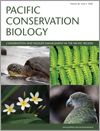
Pacific Conservation Biology
Volume 26 Number 4 2020
Understanding the extent of populations is vital to the conservation and management of at-risk species. A review of population genetic studies for carcharhinid sharks that occur in the Indo-West Pacific reveals patters according to species lifestyle. Past studies vary greatly in design and we recommend robust strategies to ensure the rigour of future genetic studies of shark populations.
A revised interpretation of a freshwater historical condition of Lake Alexandrina was used to set watering targets under the Murray Darling Basin Plan. The evidence for its natural estuarine condition is re-asserted overturning the recent conclusion that the lake was largely fresh. The recognition of a tidal past broadens the management options available under scenarios of declining flows and higher sea levels.
Invasive predators are a global biodiversity threat, especially on islands. Predator management can be challenging on islands that are large, or that have substantial human populations. We explore examples from Japan and New Zealand, which have been at the forefront in addressing these challenges.
To determine the distribution of male whale sharks in Cenderawasih Bay, we deployed 16 fin-mounted tags using a novel technique. Sharks primarily engaged in foraging-related behaviour in shallow water and travelled over deeper waters. Sharks had variable residency and seasonal dispersal patterns linked to environmental cues.
PC19053Big trouble for little fish: identifying Australian freshwater fishes in imminent risk of extinction
 , Hayley M. Geyle
, Hayley M. Geyle  , Stephen Beatty
, Stephen Beatty  , Culum Brown, Brendan C. Ebner
, Culum Brown, Brendan C. Ebner  , Rob Freeman, Michael P. Hammer, William F. Humphreys, Mark J. Kennard, Pippa Kern, Keith Martin, David L. Morgan
, Rob Freeman, Michael P. Hammer, William F. Humphreys, Mark J. Kennard, Pippa Kern, Keith Martin, David L. Morgan  , Tarmo A. Raadik, Peter J. Unmack, Rob Wager, John C. Z. Woinarski and Stephen T. Garnett
, Tarmo A. Raadik, Peter J. Unmack, Rob Wager, John C. Z. Woinarski and Stephen T. Garnett
Australian freshwater fishes have typically been neglected in conservation planning, despite evidence of catastrophic declines. Here we use structured expert elicitation to identify the Australian freshwater fishes in imminent risk of extinction. All 22 species considered had moderate to high (>40%) likelihoods of extinction in the next two decades. Using conservation progress metrics, we identify priority management needs for averting future extinctions.
The number of matched humpback whales between northern Philippines (1999–2016, 234 individuals) and Ogasawara, Japan (1987–2014, 1389 individuals) was 86, corresponding to 36.8% and 6.2% of the catalogues, respectively. We provide the latest information on interchange of humpback whales between two breeding grounds in the western North Pacific.
PC20037Extensive recent wildfires demand more stringent protection of critical old growth forest
How disturbance changes the spatial extent of old growth forests is often poorly known. Using fire data (including from the 2019–20 wildfires), logging data and vegetation type data, we found that 77% of old growth forests and woodlands across Victoria have been disturbed since 1995.
PC20037 Abstract | PC20037 Full Text | PC20037PDF (4.2 MB) Open Access Article
The northern brush-tailed phascogale (Phascogale pirata) has likely declined across its entire mainland range (monsoonal Northern Territory), but this is difficult to quantify due to the very limited baseline data available. We conducted the first targeted survey for P. pirata on Melville Island in the Northern Territory, finding that detection was more likely on large Eucalyptus tetrodonta trees in wetter months (i.e. October–April). Our approach (using motion-sensor cameras mounted on tree trunks) may be used to determine whether populations have persisted across the historic range or (where guided by suitable habitat mapping) to search for new populations.
PC19037Integrating traditional knowledge, science and conservation in the search for undescribed mammals on Malaita, Solomon Islands
 , Masaafi Alabai, Tommy Esau, Simon Fuiberi, Di'ifaka Furina, Rebecca N. Johnson, Esau Kekeubata, David MacLaren, Jackson Waneagea and Tim F. Flannery
, Masaafi Alabai, Tommy Esau, Simon Fuiberi, Di'ifaka Furina, Rebecca N. Johnson, Esau Kekeubata, David MacLaren, Jackson Waneagea and Tim F. Flannery
In Solomon Islands, new mammals continue to be described and two lineages – monkey-faced bats (Pteralopex) and giant rats (Solomys and Uromys) – are yet to be documented from the large island of Malaita, where logically they should exist. We present traditional knowledge and mammal survey results from East Kwaio, Malaita, and describe conservation measures implemented.
This study compares the results of an environmental impact assessment (EIA) vertebrate fauna survey for a project near the coast in the south-west of the Pilbara in Western Australia with the results of a fauna salvage program at the same site. It discusses why there are appreciable differences between these results in the species recorded and relative abundance of those species and makes recommendations to improve EIA surveys.
In this study, we design a behavioural change intervention to change Malaysians’ key beliefs about feeding free-roaming cats, thereby reducing the wildlife, human health, and societal impacts of the cats.
PC19050Pied Cormorant Phalacrocorax varius nestling pierces gular sac of adult resulting in death
A nestling or fledgling Pied Cormorant Phalacrocorax varius was found dead, probably drowned. Its head and neck had completely pierced an adult’s gular sac, highlighting that the method of feeding young cormorants is not perfect.



